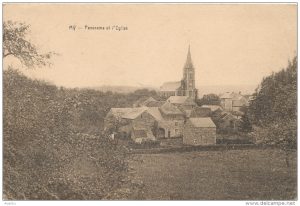My,The old lime tree salutes you
In the heart of the village, between the old castle farm, the farmhouse and the limestone church, the old lime tree dominates with its 3.77 m circumference and will tell you about its former Lords.

In the heart of the village, between the old castle farm, the farmhouse and the limestone church, the old lime tree dominates with its 3.77 m circumference and will tell you about its former Lords.

It’s along a splendid stretch planted with hundred-year-old plane trees that the peaceful village of My comes into view. In the background, the surprising and majestic Wibin-Gillard castle farm dating from the 18th century imposes its power and belonging to the seigniorial era. In the heart of the village, a king awaits you, planted in the middle of a small square: a monumental old lime tree with a split trunk gave its name to the village’s main street. This age-old tree faces the old school dating from 1840. Still alive today, it spreads the children’s laughter through the quiet narrow streets. The Rue du Vieux Tilleul has several limestone houses built mainly during the 18th and 19th centuries. They are a sign of the typical architecture of this Calestian region.
The church of the Assumption of the Virgin Mary, built of brick, stands out in the landscape. A little further on, the Gillard square farmhouse with its superb tower-porch, a former dependency of the castle, is further evidence of the importance of My a few centuries ago. Other treasures remain hidden here and there: a wrought iron lamp post and a cast iron water pump from the 19th century, still feeding seven limestone troughs where animals came to drink.
Maison du Tourisme Ourthe-Vesdre-Amblève
Rue de Louveigné, 5A
4920 Remouchamps
Tél. : +32 (0) 4/ 384 35 44
info@ovatourisme.be
Site web
Office du Tourisme de Ferrières
Place de Chablis 14a
4190 Ferrières
Tél. : +32 (0) 86/ 40 99 69
office.tourisme@ferrieres.be
The association Les Plus Beaux Villages de Wallonie (The Most Beautiful Villages of Wallonia) oversees a network of 32 villages, bearers of a strong territorial identity and reflecting traditional architecture. It is committed to promoting the rural, cultural and natural heritage of Wallonia and is a part of the development of local and responsible tourism.
More information